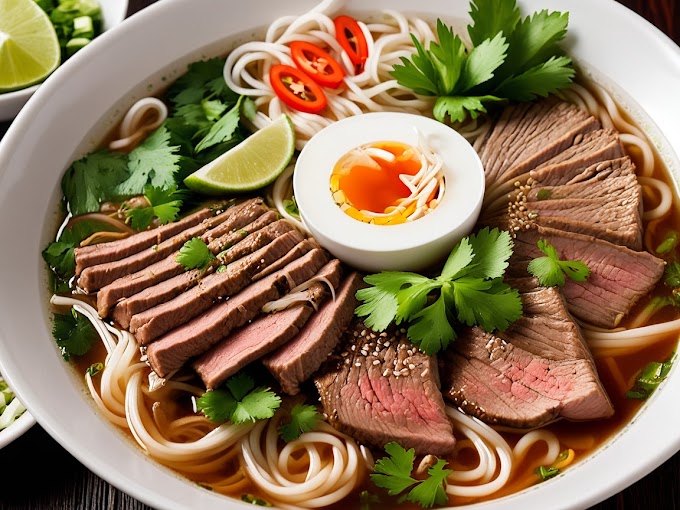Classic Beef Wellington
Introduction
Beef Wellington is a quintessential British dish that has become synonymous with celebration and grandeur. The dish typically consists of a tender beef fillet coated in a rich mushroom duxelles and pâté, all wrapped in a golden, flaky puff pastry. Named after the Duke of Wellington, this dish is a showstopper, often served at festive gatherings, holiday dinners, or special occasions. The combination of flavors and textures—from the tender meat to the earthy mushrooms and buttery pastry—creates a culinary experience that is both luxurious and comforting.
Ingredients (Serves 6)
For the Beef
- 2 pounds beef tenderloin, trimmed
- Salt and black pepper, to taste
- 2 tablespoons olive oil
- 2 tablespoons Dijon mustard
For the Mushroom Duxelles
- 1 pound cremini or button mushrooms, finely chopped
- 2 tablespoons unsalted butter
- 1 small onion, finely chopped
- 2 cloves garlic, minced
- 1 tablespoon fresh thyme leaves (or 1 teaspoon dried thyme)
- 1/2 cup dry white wine
- Salt and black pepper, to taste
For Assembly
- 8 ounces pâté (optional, such as foie gras or chicken liver)
- 1 package (14 ounces) puff pastry, thawed
- 1 egg, beaten (for egg wash)
For Serving
- Fresh herbs, for garnish (optional)
- Red wine sauce (optional)
Instructions
1. Prepare the Beef
- Season the beef tenderloin generously with salt and black pepper.
- In a large skillet, heat 2 tablespoons of olive oil over medium-high heat. Sear the beef on all sides until browned, about 2-3 minutes per side. Remove from the skillet and let it cool slightly.
- Brush the beef with Dijon mustard while it's still warm. Set aside.
2. Make the Mushroom Duxelles
- In the same skillet, add 2 tablespoons of butter. Sauté the chopped onion until translucent, about 5 minutes.
- Add the minced garlic and sauté for another 1-2 minutes until fragrant.
- Add the finely chopped mushrooms and fresh thyme, cooking until the mushrooms release their moisture and become dry, about 8-10 minutes.
- Pour in the dry white wine and cook until the liquid evaporates, stirring frequently. Season with salt and black pepper. Let the mixture cool completely.
3. Assemble the Wellington
- Roll out the puff pastry on a floured surface to a rectangle large enough to enclose the beef. Ensure it's about 1/8-inch thick.
- If using, spread the pâté evenly over the surface of the puff pastry.
- Spoon the cooled mushroom duxelles on top of the pâté (or directly on the pastry if not using pâté), spreading it evenly.
- Place the seared beef in the center of the pastry. Carefully fold the pastry over the beef, sealing the edges well to prevent any leaks. Trim any excess pastry.
- Place the wrapped Wellington seam-side down on a baking sheet lined with parchment paper.
4. Brush and Chill
- Brush the entire surface of the pastry with the beaten egg to give it a golden finish when baked.
- Refrigerate the assembled Wellington for about 15-30 minutes to help it hold its shape during baking.
5. Bake the Wellington
- Preheat your oven to 400°F (200°C).
- Once chilled, remove the Wellington from the refrigerator and brush it again with egg wash. You can also score the top with a sharp knife for decoration, being careful not to cut through the pastry.
- Bake for about 25-30 minutes or until the pastry is golden brown and the internal temperature of the beef reaches your desired doneness (125°F for medium-rare).
- Allow the Wellington to rest for 10-15 minutes before slicing.
6. Serve
- Slice the Beef Wellington into thick slices and arrange on a platter. Garnish with fresh herbs if desired. Serve with red wine sauce, mashed potatoes, or seasonal vegetables.
Tips for Perfect Beef Wellington
- Beef Quality: Use high-quality beef tenderloin for the best flavor and texture. Look for a cut that is evenly shaped and well-trimmed.
- Mushroom Duxelles: Ensure the mushroom mixture is completely cool before assembling to prevent the pastry from becoming soggy.
- Puff Pastry: Keep the puff pastry cold while working with it. If it becomes too warm, it may become difficult to handle.
Cultural Background of Beef Wellington
Beef Wellington is often associated with British cuisine and is believed to have been inspired by similar French preparations. The dish is named after Arthur Wellesley, the Duke of Wellington, who defeated Napoleon at the Battle of Waterloo in 1815. It became popular in the mid-20th century, often served at special occasions, including Christmas and New Year’s celebrations. Its luxurious ingredients and stunning presentation make it a centerpiece worthy of any festive table.
Serving Suggestions
- Accompaniments: Pair with roasted vegetables, creamy mashed potatoes, or a rich red wine sauce for a complete meal.
- Leftovers: Store any leftovers in an airtight container in the refrigerator for up to 3 days. Reheat gently in the oven to preserve the pastry.
Beverage Pairing
- Red Wine: A full-bodied red wine, such as Cabernet Sauvignon or Merlot, complements the richness of the beef.
- Champagne: For a festive touch, serve with sparkling wine or champagne to balance the flavors.
- Herbal Tea: A warm herbal tea can also be a delightful non-alcoholic option to serve alongside.
Final Thoughts
Classic Beef Wellington is a dish that embodies elegance and sophistication. Its combination of tender beef, earthy mushrooms, and flaky pastry creates a memorable dining experience that is sure to impress your guests. Whether for a holiday feast or a special celebration, Beef Wellington is a true culinary masterpiece that will be cherished and savored. Embrace the art of cooking and delight in the flavors of this timeless dish!








0 Comments